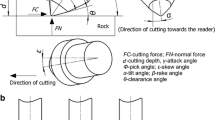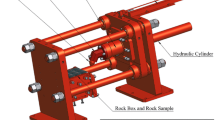Abstract
The best means to assess rock cuttability and efficiency of cutting process for using mechanical excavation is specific energy (SE), measured in full-scale rock cutting test. This is especially true for the application of roadheaders, often fitted with drag-type cutting tools. Radial picks or drag bits are changed during the operation as they reach a certain amount of wear and become blunt. In this study, full-scale cutting tests in different sedimentary rock types with bits having various degree of wear were used to evaluate the influence of bit wear on cutting forces and specific energy. The relationship between the amount of wear as represented by the size of the wear flats at the tip of the bit, and cutting forces as well as specific energy was examined. The influence of various rock properties such as mineral content, uniaxial compressive strength, tensile strength, indentation index, shore hardness, Schmidt hammer hardness, and density with required SE of cutting using different levels of tool wear was also studied. The preliminary analysis of the data shows that the mean cutting forces increase 2–3 times and SE by 4–5 times when cutting with 4 mm wear flat as compared to cutting with new or sharp wedge shape bits. The grain size distribution of the muck for cutting different rock types and different level of bit wear was analyzed and discussed. The best fit prediction models for SE based on statistical analysis of laboratory test results are introduced. The model can be used for estimating the performance of mechanical excavators using radial tools, especially roadheaders, continuous miners and longwall drum shearers.









Similar content being viewed by others
References
Acar C, Hosten Ç (2013) Grinding kinetics of steady-state feeds in locked-cycle dry ball milling. Powder Technol 249:274–281
Atkinson T, Cassapi VB, Singh RN (1986) Assessment of abrasive wear resistance potential in rock excavation machinery. Int J Min Geol Eng 4:151–163
Balci C, Bilgin N (2005) Comparison of small and full scale rock cutting tests to select mechanized excavation machines, Istanbul Technical University, Mining Engineering Department
Balci C, Demircin MA, Copur H, Tuncdemir H (2004) Estimation of optimum specific energy based on rock properties for assessment of roadheader performance. J S Afr Inst Min Metall 104:633–642
Bilgin N, Yazici S, Eskikaya Ş (1996) A model to predict the performance of roadheaders and impact hammers in tunnel drivages. EUROCK’96, Torino, pp 710–721
Bilgin N, Dincer T, Copur H, Erdogan M (2004) Some geological and geotechnical factors affecting the performance of a roadheader in an inclined tunnel. Tunn Undergr Space Technol 19:629–636
Bilgin N, Copur H, Balci C (2012) Effect of replacing disc cutters with chisel tools on performance of a TBM in difficult ground conditions. Tunn Undergr Space Technol 27(1):41–51
Bolukbasi N (1973) Studies on the design and operation of some longwall mining systems using A1/4 scale model. Ph.D. Thesis, University of New Castle Upon Tyne
Bolukbasi N (1989) Indication of excavation capability for A. O. L. Beypazarı region rocks. Middle East Technical University, Mining Engineering Department, Ankara
Copur H, Balci C, Tumac D, Bilgin N (2011) Field and laboratory studies on natural stones leading to empirical performance prediction of chain saw machines. Int J Rock Mech Min Sci 48(2):269–282
Copur H, Ozdemir L, Rostami J (1998) Roadheader applications in mining and tunneling. Min Eng 50(3):38–42
Dalziel JA, Davies E (1964) Initiation of cracks in coal specimens by blunted wedges. Engineering 217:217–220
Dogruoz C (2010) Effect of pick blunting on cutting performance for weak-moderate rocks, Ph.D Thesis, Mining Engineering Department, Middle East Technical University, Turkey, p 144
Dogruoz C, Bolukbasi N (2014) Effect of cutting tool blunting on the performances of various mechanical excavators used in low- and medium-strength rocks. Bull Eng Geol Environ 73(3):781–789
Evans I (1974) Relative efficiencies of picks and discs for cutting rocks. Advances in rock mechanics. In: Proceedings of 3rd conference of International Society For Rock Mechanics, Denver, USA, vol 2-B, National Academy of Sciences, p 1399
Evans I (1984) A theory of the cutting force for point attack picks. Int J Min Eng 2(1):63–71
Evans I, Pomeroy CD (1966) The strength, fracture and workability of coal. Pergamon Press, London, p 217
Fowell RJ (1973) Studies on the application of percussively activated tools to reef slotting in some South African Quartzites. Ph.D. Thesis, University of Newcastle upon Tyne, December
Fowell RJ, Johnson ST (1982) Rock classification and assessment for rapid excavation. Proceedings of the symposium on Strata Mech. Newcastle Upon Tyne, pp 241–244
Fowell RJ and Pycroft AS (1980) Rock machinability studies for the assessment of selective tunnelling machine performance. 21st national rock mechanics symposium, Miss, USA, pp 149–158
Fowell RJ, Pycroft AS (1982) Rock machineability studies for the assessment of the selective tunneling. Elsevier, Newcastle Upon Tyne, pp 241–244
Fowell RJ, Richardson G, Gollick MJ (1994) Prediction of boom tunnelling machine excavation rates. In: Nelson PP, Laubach S (eds) Proceedings of the symposium on rock mechanics models and measurements challenges form industry, pp 243–51
Gehring KH (1989) A cutting comparison. Tunn Tunn 21:27–30
ISRM (2007) The complete ISRM suggested methods for rock characterization, testing and monitoring: 1974–2006
Goktan RM, Gunes N (2005) A comperative study of schmidt hammer testing procedure with reference to rock cutting. Int J Rock Mech Min Sci 42:466–472
Keles S (2005) Cutting performance assessment of a medium weight roadheader at Çayırhan coal mine. M.Sc. Thesis, Middle East Technical University, p 58
Kenny P, Johnson SN (1976) The effect of wear on the performance of mineral-cutting tools. Collieary Guard 246:246
McFeat-Smith I (1975) Correlation of rock properties and tunnel machine performance in selected sedimentary rocks. Ph.D. Thesis, University of Newcastle upon Tyne, June
McFeat-Smith I, Fowell RJ (1976) Factors ınfluencing the cutting performance of a selective tunnelling machine. In: Proceedings of tunnelling symposium, 76. Department of Mining Engineering, University of Newcastle upon Tyne, England, p 301
McFeat-Smith I, Fowell RJ (1977) Correlation of rock properties and the cutting performance of tunnelling machines. In: Proceedings conference on rock engineering, Newcastle upon Tyne, 4–7 April, p 581
McFeat-Smith I, Fowell RJ (1979) The selection and application of roadheaders for rock tunnelling. In: Maevis AC, Hustrulid WA (eds) Proceedings of the rapid excavation and tunnelling congress, Atlanta, p 261–79
Neil DM, Rostami J, Ozdemir L, Gertsch R (1994) Production estimating techniques for underground mining using roadheaders. SME, AIME annual meeting, Albuquerque, New Mexico
Rostami J, Ozdemir L, Neil DM (1994) Application of heavy duty roadheaders for underground development of the Yucca Mountain exploratory study facility. In: Proceedings of international high level nuclear waste management conference, Las Vegas, NV, pp 17–20
Rostami J, Monroe S, Ozdemir L (1998) Issues related to design and performance optimization of continuous for increased productivity. SME/AIME 1998 annual meeting and exhibit, March 9–11, Orlando, Florida (Preprint #98–218)
Roxborough FF, Phillips HR (1974) Experimental studies on the excavation of rocks using picks. Advances in rock mechanics. In: Proceedings of the 3rd ISRM Congress, Denver
Thuro K, Plinninger RJ (1999) Roadheader excavation performance—geological and geotechnical influences, 9th ISRM Congress Paris, Theme 3: rock dynamics and tectonophysics/rock cutting and drilling
Yagiz S (2009) Assessment of brittleness using rock strength and density with punch penetration test, tunnelling and underground space technology. Elsevier, Amsterdam, pp 66–74
Author information
Authors and Affiliations
Corresponding author
Rights and permissions
About this article
Cite this article
Dogruoz, C., Bolukbasi, N., Rostami, J. et al. An Experimental Study of Cutting Performances of Worn Picks. Rock Mech Rock Eng 49, 213–224 (2016). https://doi.org/10.1007/s00603-015-0734-x
Received:
Accepted:
Published:
Issue Date:
DOI: https://doi.org/10.1007/s00603-015-0734-x




